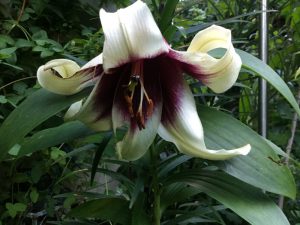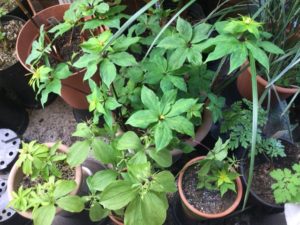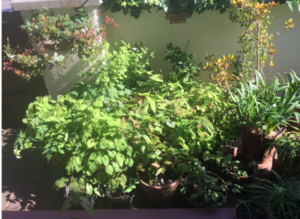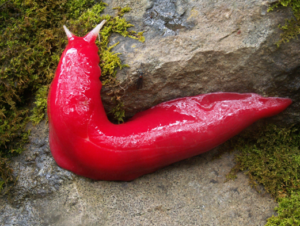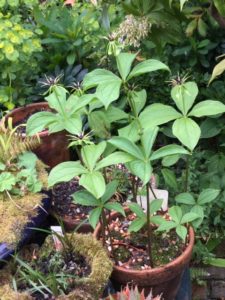MAY AND JUNE IN OUR GARDENS by Philippa Thomas.
What A Roller Coaster our Last Number of Weeks have Been.
Closing our hall doors to our family and friends feels so bizarre and strange, yet we truly know that it has to be done. While Coronavirus has undoubtedly, brought so many traumatic changes to our world, it certainly is also serving as a powerful reminder of how ultimately our lives are bound to the earth and to each other. It seems to have created a new tribe who are suddenly deeply determined to grow at least a little of their own food. Don’t we really just simply want to be out in the garden right now and we almost feel to have a compulsion to plant and grow….. There is nothing more life affirming than getting your hands in the soil and planting. We are taking some time now to restore, to re-energise. For now, stay safe and keep healthy.
- Check Lilies for Scarlet Lily Beetle and their larvae as they rapidly strip plants of all their foliage.
Our May Days Are Longer And Warmer, Our Welcome Summer is On its Way!
Growing native wild flowers in our garden is a wonderful way to support pollinators and other creatures that are part of our ecosystem. Perhaps, sow an annual meadow. THE SECRET OF GETTING AHEAD IS GETTING STARTED. Some wild flowers are edible, (please check,) some can be used to make wine; some can be used to scent presses. You may even have native plants in your soil that you didn’t know about. Lawns are a sterile desert as far as wild life is concerned, by simply stopping mowing you could do wonders for birds, bees, butterflies and other insects, hedgehogs and other small mammals….. You may be simply amazed at what comes up.…. maybe even native orchids; there are at least 30 native species. – Maybe, in order to make your meadow look intentional and not neglected, mow paths through a wild patch for sun bathing or for enjoying picnics, play areas or even for meditation. Remember, a tree, its shape, its structure, its light and shade can empower such beauty. The smaller and barer a garden, the more the reason to bring our woodland back with small decorative trees, like Amelanchiers, glossy Camellias, beautiful low maintenance Ferns, etc.#
- Jasminum Polyanthum, Scented Indoor Jasmine, Still In Flower.
Our Future Generation, Our Dalkey Children.
Maybe, think about LARGE SEEDS for little fingers, quick germination and results. Dwarf French beans are ideal and children generally like eating them. You can choose yellow and purple ones, buy on Irish internet. Radishes grow in 6 weeks and are delicious when young, Cherry Belle, excellent ….. I believe Romance FJ, or Amsterdam are super carrots for quick results also delicious eaten raw. You will need to protect them from carrot root-fly with horticultural fleece. Then, you can show your children how strawberries produce runners so that you can grow loads this coming summer, Elsanta & Cambridge are favourites. Tumbling Tom Tomatoes can be grown in pots; Sungold will have them eating them like sweets!
Sowing a pack of wild flowers will attract bees and butterflies and instill a love of nature.
- 4 Different Parises…Or True Lovers Knot, Woodland. Absolutely Adore Them. They Produce Spider-Like Flowers That Throw Out Long, Thread-Like, Yellowish Green Petals.
“A child’s mind is like a shallow brook which ripples and dances merrily over the stony course of its education and reflects here a flower, there a brush, yonder a fleecy cloud”.
Helen Keller, 1880 –1968.
“If a child is to keep his inborn sense of wonder, he needs the companionship of at least one adult who can share it”.
Rachel Carson, 1907 to 1964 Environmentalist.
“The object of teaching a child is to enable him to get along without his teacher”. Elbert Hubbard, 1856 – 1915 “No bubble is so iridescent or floats longer than that blown by the successful teacher”
William Oster, Canadian Physician. 1849 – 1919.
- My Party Of Epimediums Or Fairy Wings. Couldn’t Live Without Collection. All In Terracotta Pots In Shady Area.
How To and Grow For The First Time.
As long as a few basic principles are followed, it unlocks the door to a world of possibilities, empowering you to grow a vast range of plants.
…. Once seedlings have germinated they need space to establish a strong root system. It is important to prick out as soon as the plant is ready which is usually when the first two leaves emerge, (i.e. the second set of leaves that emerge after the seed.) Transfer into new pot or cell plug tray, using a pen or biro or simply your fingers to lightly prise it out from the compost while taking care to keep its baby root system intact.
- Magnolia Laevifolia, Gail’s Favourite, Slow Growing, Evergreen And Scented….Am Training It On Our Outer Wall, Right By Our Gate….Just Love It…..
Fluorescent Pink Slug Survives The Australian Bush Fires. As Australia begins to count the cost to the environment of this year’s devastating bush fires, one survivor was a species of fluorescent pink slug that lives in Mount Kaputar in Northern New South Wales. It is thought they survived by hiding in rock crevices. Unfortunately, its colour and less bush cover means it’s easy for predators to spot.
- One survivor of Australia’s recent devastating bush fires is The Pink Fluorescent Slug that lives in Mount Kaputar in northern New South Wales. It is thought they survived by hiding in rock crevices.
Might Do/Maybe May Jobs.
- During our Exceptionally Precious, unique Strange Times maybe take a deep breath, put down the remote and get busy outside, nothing to lose, enjoy!
- Once spring bulbs are over rather than cutting down the foliage, leave to die back naturally, adding some liquid fertiliser around the clumps, will encourage strong growth next spring.
- Get composting – collect dried leaves, twigs, grass clippings, stable bedding or straw, kitchen scraps, coffee grounds, egg shells, shredded newspapers, even old potting soil.
- Plant out summer bedding and tender annuals, including sunflowers, cosmos, nasturtiums, after the last frosts. Pinch out shoot tips of bedding plants and young annuals to encourage bushier growth. Check lilies and fritillaries for scarlet lily beetle and their larvae as they can rapidly strip plants of all their foliage.
- Avoid having to stare at a blank grey wall by hanging up some environmentally friendly, biodegradable hessian flower bags.
- Shed some light. Maybe, string up some garden lights to bring a sparkle to a tree, porch, archway or beautiful shrub. Put them where you can see and enjoy them from the house.
- You may find herbs in the supermarket with their roots still attached. Water them well when you get home. These are mostly raised from seed and many young plants are lightly packed together in each pot. These can be split into several smaller clumps and re-potted at anytime during the growing season. Chamomile, Chives, Flat and Curly Leaved Parsley, Some Sages, Mint, Thyme, Rosemary, Oregano, Coriander, Basil then, which needs warmth.
- Veg To Plant out in May There is such a choice out there… ..Maybe Try Artichokes, Beetroot, Carrots, Celery, Courgettes, Chicory, Cucumber, French Beans, Kohlrabi, Runner Beans, Salad Leaves, Spring Onions, Squash, Sprouting Broccoli, Sweetcorn, Tomatoes……
- Paris Quadrifolia, Loves Cool Areas, Eurasia.
“May, More Than Any Other Month Of The Year Wants Us To Feel Most Alive”.
Fennel Hudson.
“I’ve Always Felt That Having A Garden Is Like Having A Good And Loyal Friend”.
C. Z. Guest.

